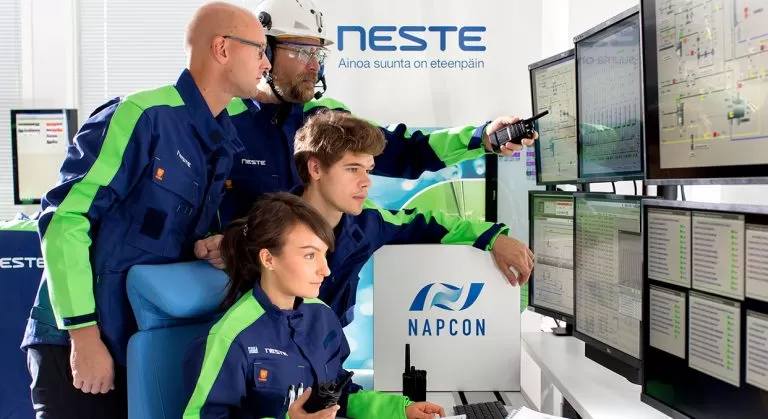Virtual Reality is Making Marketing and Training More Effective for Businesses

Share this blog
Virtual reality (VR) has largely rolled out as an entertainment technology, but the (actual) reality is that VR also boasts serious business capabilities. Whether it’s test-driving a product or boosting customer loyalty, VR is especially effective when it comes to cultivating a rich consumer experience and marketing your products and services. But the potential uses for VR don’t stop there; experts agree that in the future, VR will offer even more powerful capabilities to businesses and individuals alike.
It’s worth mentioning VR’s relation to augmented reality (AR), which uses 3D models to “augment” the real, physical world. VR, on the other hand, creates an environment that’s entirely separate from the one you’re standing in. Some experts told Business News Daily that they expect these technologies to converge over time. Indeed, that trend is already visible with the creation of products like Microsoft’s HoloLens, a headset with immense processing power that enables users to access both VR and AR programs.
Virtual reality's business applications
From taking stock of inventory to hosting virtual conferences, VR can be applied to a slew of business needs. In general, VR allows users to immerse themselves in an environment that synthesizes a vast amount of data and presents it in a way that’s simple to understand and navigate. That data can then be stored and archived so that users can monitor trends over time.
Virtual reality is especially effective for marketing, because it creates an opportunity for businesses to establish a strong emotional connection among target consumers and their product.
“Right now, the most successful business use is marketing experience,” Maria Korolov, editor and publisher of business tech publication Hypergrid Business, said. “You take a little bit of your product, put it into a virtual environment and have people use it. It’s particularly popular with movies. You get the eye contact, you feel like you’re in a different location.”
Get in Touch
Related Blogs

The 5 FinTech Product Engineering Trends Quietly Reshaping Global Finance

Bridging the Gap Between Innovation and Measurable Performance in the Banking Industry

Cloud at the Heart of Digital Manufacturing

Agile Methodologies in Retail Product Development: Flexibility and Responsiveness to Market Changes

The Nordic AI Advantage: Operations That Actually Work

Social Commerce, Mobile Commerce & Smart Commerce: The New Triad of Digital Growth

Staying Ahead in the AI Search Era: How GEO Complements Traditional SEO

CIOs, It’s Time to Lead AI in Healthcare—Not Just Watch It

Balancing Feature Development with Platform Enhancement: A Strategic Imperative

Managing IT Costs Effectively: A Strategic Approach to Balancing Growth and Efficiency

The Hidden Complexity of Scaling Cloud Operations: What Most Strategies Miss

Managing Technical Debt: Balancing Innovation with Sustainability

Maintaining Development Velocity While Ensuring Quality: The Balancing Act

Navigating Financial Strategies for Global Expansion in SaaS

Precision in Complexity: Redefining Capital Allocation for Sustainable Growth

Beyond Silos: Rethinking Cross-Functional Collaboration for Scalable Product Development

Simplifying Global Expansion: The Power of One Strategic Partner

The Unfinished Symphony of Digital Transformation: From Strategy to Execution

Beyond Traditional Process Intelligence: Integrating Emerging Technologies for a Competitive Edge

Tekninen Velka – Kuinka Se Haittaa Kasvua ja Miten Sen Saa Hallintaan?

A Deep Dive into Product Engineering: Process, Roles, and Best Practices

What is Cyber Resilience? An In-Depth Guide

A Comprehensive Guide to Cloud Transformation

24 Emerging Software Development Trends Transforming 2024

Is AI Secure? Addressing Cybersecurity Risks with AI

How Is Cloud Computing Transforming Sustainable Healthcare in the Nordics?

Gateway Digital is Neste Napcon’s Partner in Creating Digital Learning Environments for the Process Industry

Tuotekehitysyhteistyön avulla joustavuutta ja kustannushyötyjä – Case School Day

Petteri paju vahvistamaan Gatewayn myyntiä

Top 6 Trends Transforming Logistics and Supply Chain in 2020

Why is it Important to Hire the Right Employees to Grow your Business?

Miten IT-alan ammattilaisten vaje näkyy Suomessa?

How Can Emerging Technology Facilitate Faster Start-up Growth?

The Need For Smart Logistic Planning: Takeaways From The Suez Canal Crisis

Gateway Digital AS and Retailtech strengthen their strategic partnership

Gateway Digital and Digitate enters strategic partnership

The DACH cloud computing industry in 2021 and beyond

Why Germany is home to the most innovative Tech Startups

Dataplattform för att identifiera bilreservdelar vinner pris inom hållbarhet

AWS vs GCP vs Microsoft Azure: Everything you need to know

Ensuring a higher ROI on your Technology Investment: Here’s How

Why the future of Startups & Scaleups depends on Technology Partner

Infographic: Elevate your Business with Augmented Supply Chain

Infographic: Empowering the Digital Healthcare Ecosystem

Infographic: Why Strategic Technology Partnerships are imperative for ISVs

Infographic: How PES is Empowering the Digital Healthcare landscape

Impact of Covid 19 on the Automotive Industry

How COVID-19 is Changing the Face of Digital Healthcare

Transform your Digital Journey with Strategic Technology Partnerships

Succeed your Business with Partnerships – The New Normal for Fintech!

Supply Chain Focus Areas to Mitigate COVID-19 Disruptions

How Digital Transformation is Redefining the Healthcare Industry

Benefits of Digitising Your Product Development Process

How to Develop a New Product (From Concept to Market)

How Automotive and Technology Experts See the Future of Connected Vehicles through Future Tech 5G Service

Industry Digitization will be Top Opportunity for 5G business solutions

5G Products & Solutions in 2023 & Beyond– What Should we expect from 5g network software?

Everything You Need to Know About 5G network as a service

Cloud Companies Chase Future in Cybersecurity ‘Wild West’

The Future of Lawyers: Legal Tech, AI, Big Data And Online Courts

Why Covid-19 Could Expedite the Role of RegTech in Finance

3 Elements For Success With Mobility As A Service In Our Cities

Digitalization is Upending Global Logistics

Mastering the Duality of Digital: How Companies Withstand Disruption

iGaming Technology Trends to Watch

73% Growth and Instant Blockbusters: How Online Gaming Industry Is Blowing Up During the Pandemic

The 5 Biggest Cybersecurity Trends In 2020 Everyone Should Know About

Why Cybersecurity Is Really A Business Problem

Technological Disruption or Next Industrial Revolution?

What Will Be The Future Success Of Fashion Retail In The Digital Age

The Banking Industry Is Spending Wildly on the Latest Tech

Disruption in Manufacturing: Managing Unexpected Risks

5 Manufacturing Tech Trends Poised To Disrupt Your Business

Digital Disruption in the Manufacturing Industry

Future Factory: How Technology Is Transforming Manufacturing

Five Ways the Internet of Things is Transforming Businesses Today

The Mobility-as-a-Service Market will Register a CAGR of Over 35% by 2023

3 Ways Every Company Should Prepare For The Internet Of Things

The Three Stages Of Cloud Transformation: Application, Network, Security

Cloud Computing Seen as Tech Haven Amid Pandemic Uncertainty

How Multi-Cloud and Digital Transformation Fit Together

8 Ways Cloud Is Transforming Business

Mixed Reality Finds Its Niche in Industrial and Business Applications

What Leaders Need To Know About Augmented Reality

The 5 Biggest Virtual And Augmented Reality Trends In 2020 Everyone Should Know About

DevOps Model: The Role of Quality Assurance Redefined

Quality Engineering Has DevOps and Agile in the Driving Seat

How QA Can Support Businesses in the Journey of Digital Transformation

Quality Assurance Is Critical In Software Development And Increasingly Automated

Resolving Challenges of Auto ISVs with Fruitful Technology Partnerships

Resolve Fleet Management Challenges with Innovative Digital Automotive Solutions

Top 3 Factors Impacting Customer Satisfaction of Modern Car Buyers

Fleet Telematics Solution: Driving Great Business for Automotive Ecosystems

Top Supply Chain Tech Trends

How Artificial Intelligence Benefits Logistics and Supply Chain Management

Fleet Management in 2024 & Beyond: What Does the Future Look Like?

How to Identify a Trusted online iGaming Solutions Provider?

Mastering Enterprise Digital Transformation: Building Blocks of a Successful Strategy

Center of Excellence: Building Intelligent Solutions for the Enterprises of Tomorrow

Want to Succeed in Digital Transformation? Choose the Right Technology Partner
INDUSTRIES
PLATFORMS
SERVICES
CONSULTING
- AlvariumTM - Design Led ConsultingOpens a new window
- Digital Marketing Services
- Automotive Aftermarket
- Digital Logistics
- Remote Engineering
PROFESSIONAL SERVICES
DIGITAL
FUTURE ENGINEERING
Let's Talk
Book a Meeting
We value your privacy.
This website uses cookies and similar technologies to improve your browsing experience, measure our audience, collect useful information, and provide you with relevant content. By selecting “Accept & Continue”, you confirm that you provide your consent for the use of your information, and have read and agree to our Privacy Policy , and Terms of Use.DeclineAccept & ContinueCookie settings
Privacy Overview
| Cookie | Duration | Description |
|---|---|---|
| cookielawinfo-checkbox-analytics | 11 months | This cookie is set by GDPR Cookie Consent plugin. The cookie is used to store the user consent for the cookies in the category "Analytics". |
| cookielawinfo-checkbox-functional | 11 months | The cookie is set by GDPR cookie consent to record the user consent for the cookies in the category "Functional". |
| cookielawinfo-checkbox-necessary | 11 months | This cookie is set by GDPR Cookie Consent plugin. The cookies is used to store the user consent for the cookies in the category "Necessary". |
| cookielawinfo-checkbox-others | 11 months | This cookie is set by GDPR Cookie Consent plugin. The cookie is used to store the user consent for the cookies in the category "Other. |
| cookielawinfo-checkbox-performance | 11 months | This cookie is set by GDPR Cookie Consent plugin. The cookie is used to store the user consent for the cookies in the category "Performance". |
| viewed_cookie_policy | 11 months | The cookie is set by the GDPR Cookie Consent plugin and is used to store whether or not user has consented to the use of cookies. It does not store any personal data. |
